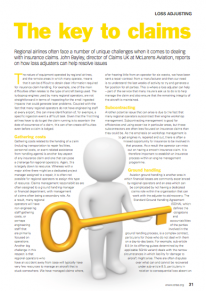Regional airlines often face a number of unique challenges when it comes to dealing with insurance claims. John Bayley, director of Claims UK at McLarens Aviation, reports on how loss adjuster can help resolve issues.
The nature of equipment operated by regional airlines, and the remote areas in which many operate, means that it can be difficult to obtain clear information required for insurance claim handling. For example, one of the main difficulties often relates to the type of aircraft being used. The turboprop engines used by many regional operators, are not straightforward in terms of inspecting for the small ingested impacts that could generate later problems. Coupled with the fact that many regional operators do not have engineering staff at every airport, this can make identification of, for example, a specific ingestion event a difficult task. Given that the first thing airlines have to do to get the claim running is to ascertain the date of occurrence of a claim, this can often create difficulties even before a claim is lodged.
Gathering Costs
Gathering costs related to the handling of a claim (including transportation to repair facilities, personnel costs, or event-related assistance from handling agents) is another key aspect of any insurance claim and one that can post a challenge for regional operators. Again, this is largely down to resource. Whereas with a major airline there might be a dedicated project manager assigned to a repair, it is often not possible for regional operators to assign this type of resource. Claims management responsibilities are often assigned to a ground handling manager or financial department, with management of claims often being a secondary role. As a result, many regional operators will have non-engineering staff gathering costs, or perhaps engineering staff that are primarily focused on operations. Another big challenge in this respect is that regional operators who have an accident away from base will typically have very few resources to manage an aircraft that is stuck somewhere. We have managed claims where, after hearing little from an operator for six weeks, we have been sent a repair contract from a manufacturer and then our need is to understand the last weeks of activity to try and generate a fair position for all parties. This is where a loss adjuster can help – part of the service that many insurers ask to do is to help manage the claim and also ensure that the remaining integrity of the aircraft is maintained.
Subcontracting
Another potential issue that can arise is due to the fact that many regional operators subcontract their engine workshop management. Subcontracting management is good for efficiencies and using expertise in particular areas, but those subcontractors are often less focused on insurance claims than they could be. As the emphasis on workshop management is to get engines in, repaired and out, there is often a missed opportunity for insurance to be involved in that process, As a result the operator can miss out on having a smooth insurance claim. It is therefore important to establish an insurance process within an engine management programme.
Ground Handling
Aviation ground handling is another area in which financial losses are commonly experienced by regional operators and an area which can be complicated by not having a dedicated claims role within the organisation that can work with the adjuster to aid recovery. The Standard Ground Handling Agreement (SGHA), which defines the obligations and accountabilities of the parties involved in the ground handling process, is a complex contract, particularly for those who do not deal with them on a day-to-day basis. For example, sub-article 8.5 (in its differing guises determined by the applicable SGHA variant) deals with the narrow circumstances in which liability for damage to aircraft might arise. There are often disputes over what can and cannot be recovered under sub-article 8.5, particularly in relation to consequential loss absent an intentional or reckless act. Consequential loss can often far exceed the level of costs for the incident related repairs, and particularly if an aircraft has suffered damage so that it remains grounded and is out of service for any significant length of time. The IATA Airport Handling Manual seeks to provide guidance on how carriers and handling companies might wish to treat losses arising consequent to physical damage to aircraft, but it does not currently form part of the SGHA unless specific provision is made for it to be included within the contract; it remains merely a guide and can all too frequently lead to disputes between the contracting parties.
So what’s the answer?
While regional airlines do face challenges, the key to overcoming them lies in having a proactive dialogue with their brokers, insurers, and adjusters, The adjuster is there to support the airline and help develop a solution that is best for all parties. It is also worth mentioning that taking a proactive approach to risk management is key. Identifying and mitigating risks, by conducting a risk audit, can have a significant impact on the claims management process. This is becoming increasingly common, with the focus of such audits being on helping the operator give a broader consideration as to how it can operate the aircraft safely with the necessary infrastructure to manage it, while understanding its maintenance and operational capabilities.
This article originally appeared in the April edition of ERAA‘s (European Regions Airline Association) publication Regional International.





